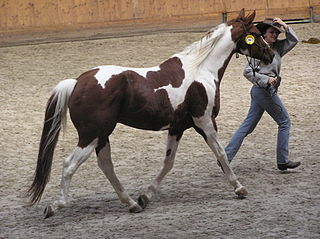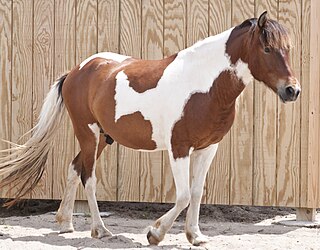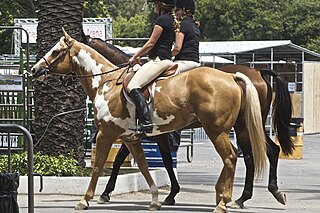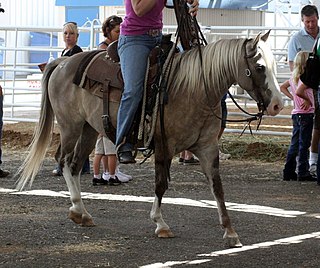Related Research Articles

The American Quarter Horse, or Quarter Horse, is an American breed of horse that excels at sprinting short distances. Its name is derived from its ability to outrun other horse breeds in races of a quarter mile or less; some have been clocked at speeds up to 44 mph (70.8 km/h). The development of the Quarter Horse traces to the 1600s.

The Appaloosa is an American horse breed best known for its colorful spotted coat pattern. There is a wide range of body types within the breed, stemming from the influence of multiple breeds of horses throughout its history. Each horse's color pattern is genetically the result of various spotting patterns overlaid on top of one of several recognized base coat colors. The color pattern of the Appaloosa is of interest to those who study equine coat color genetics, as it and several other physical characteristics are linked to the leopard complex mutation (LP). Appaloosas are prone to develop equine recurrent uveitis and congenital stationary night blindness; the latter has been linked to the leopard complex.

The American Paint Horse is a breed of horse that combines both the conformational characteristics of a western stock horse with a pinto spotting pattern of white and dark coat colors. Developed from a base of spotted horses with Quarter Horse and Thoroughbred bloodlines, the American Paint Horse Association (APHA) breed registry is now one of the largest in North America. The registry allows some non-spotted animals to be registered as "Solid Paint Bred" and considers the American Paint Horse to be a horse breed with distinct characteristics, not merely a color breed.

Lethal white syndrome (LWS), also called overo lethal white syndrome (OLWS), lethal white overo (LWO), and overo lethal white foal syndrome (OLWFS), is an autosomal genetic disorder most prevalent in the American Paint Horse. Affected foals are born after the full 11-month gestation and externally appear normal, though they have all-white or nearly all-white coats and blue eyes. However, internally, these foals have a nonfunctioning colon. Within a few hours, signs of colic appear; affected foals die within a few days. Because the death is often painful, such foals are often humanely euthanized once identified. The disease is particularly devastating because foals are born seemingly healthy after being carried to full term.

A piebald or pied animal is one that has a pattern of unpigmented spots (white) on a pigmented background of hair, feathers or scales. Thus a piebald black and white dog is a black dog with white spots. The animal's skin under the white background is not pigmented.

Skewbald is a colour pattern of horses. A skewbald horse has a coat made up of white patches on a non-black base coat, such as chestnut, bay, or any colour besides black coat. Skewbald horses which are bay and white are sometimes called tricoloured. These horses usually have pink skin under white markings and dark skin under non-white areas. Other than colour, it is similar in appearance to the piebald pattern. Some animals also exhibit colouration of the irises of the eye that match the surrounding skin. The underlying genetic cause is related to a condition known as leucism. The term is also used to describe spotting patterns in various other animals, such as goats.

The Quarab is a horse breed from the United States, developed from a part-Arabian cross of Arabian horses, American Quarter Horses and Paint horses. Members of the breed are found that resemble all three of the foundation breeds, leading to three recognized types: Straight or Foundation, Stock and Pleasure. Although there have been records of crosses between the three breeds throughout the history of their respective registries, the first Quarab registry was formed in 1984, but later went out of business. In 1999, the International Quarab Horse Association was formed and remains the leading force in Quarab breeding. In order to be registered with the IQHA, horses must have at least 1/8 blood from both the Arabian and stock horse types.

A pinto horse has a coat color that consists of large patches of white and any other color. The distinction between "pinto" and "solid" can be tenuous, as so-called "solid" horses frequently have areas of white hair. Various cultures throughout history appear to have selectively bred for pinto patterns.

Tobiano is a spotted color pattern commonly seen in pinto horses, produced by a dominant gene. The tobiano gene produces white-haired, pink-skinned patches on a base coat color. The coloration is almost always present from birth and does not change throughout the horse's lifetime, unless the horse also carries the gray gene. It is a dominant gene, so any tobiano horse must have at least one parent who carries the tobiano gene.

Overo refers to several genetically unrelated pinto coloration patterns of white-over-dark body markings in horses, and is a term used by the American Paint Horse Association to classify a set of pinto patterns that are not Tobiano. Overo is a Spanish word, originally meaning "like an egg".There are at least three genetically different spotting patterns which fall under the "overo" classification: frame overo, sabino overo, and splash or splashed white overo.

Horses exhibit a diverse array of coat colors and distinctive markings. A specialized vocabulary has evolved to describe them.

Sabino describes a distinct pattern of white spotting in horses. In general, Sabino patterning is visually recognized by roaning or irregular edges of white markings, belly spots, white extending past the eyes or onto the chin, white above the knees or hocks, and "splash" or "lacy" marks anywhere on the body. Some sabinos have patches of roan patterning on part of the body, especially the barrel and flanks. Some sabinos may have a dark leg or two, but many have four white legs. Sabino patterns may range from slightly bold face or leg white markings—as little as white on the chin or lower lip—to horses that are fully white.
Driftwood (1932–1960) was originally known as Speedy while he was a rodeo horse. Driftwood was known for siring rodeo and ranch horses.
A cropout, crop-out or crop out is a horse with body spots, including pinto or leopard complex spotting, or "high white" horse markings, with a sire and dam who both appeared to have been solid-colored. There are several variations in the definition, depending on the breed registry involved. There are multiple genetic reasons that may cause a horse to be a cropout. Sometimes solid-colored horses throw cropouts because some spotting patterns are recessive genes that are not necessarily expressed unless the relevant allele is inherited from both parents. Other times a gene may be a dominant or incomplete dominant but so minimally expressed that the horse looks solid but can pass flashy color on to its offspring.

Splashed white or splash is a horse coat color pattern in the "overo" group of spotting patterns that produces pink-skinned, white markings. Many splashed whites have very modest markings, while others have the distinctive "dipped in white paint" pattern. Blue eyes are a hallmark of the pattern, and splash may account for otherwise "solid" blue-eyed horses. Splashed white occurs in a variety of geographically divergent breeds, from Morgans in North America to Kathiawari horses in India. The splashed white pattern is also associated with congenital deafness, though most splashed whites have normal hearing. Splashed white can be caused by multiple variants across two different genes, for which genetic testing is available.
The Pinto Horse Association of America (PtHA) registers horses, utility horses, ponies and miniature horses of various pedigrees with certain kinds of pinto coat colors. The word pinto is Spanish for "paint." In general terms, pinto can apply to any horse marked with unpigmented pink-skinned, white-haired areas on its coat. The Pinto Horse Association of America provides the owners and riders of pintos with a show circuit and a breed organization. The primary requirement for PtHA registration is coat color; the pinto is not a true breed, but a color breed.

The Quarter Pony is a breed of pony that is similar to the American Quarter Horse. It stands up to 14.2 hands high and was developed from American Quarter Horse foundation bloodstock. The breed was originally developed from Quarter Horses that did not meet the American Quarter Horse Association's height requirement. It is bred to look like a small Quarter Horse, although the various registries also allow crosses with other breeds, including Paint horse, Appaloosa and Pony of the Americas, all stock types. There are three registries for the Quarter Pony, all with slightly different registration requirements. The first registry was begun in 1964, and two more were started in the 1970s. The breed is used today in a variety of Western riding disciplines.

The Pintabian horse is an American part-Arabian horse breed. It has over 99% Arabian blood, but also exhibits the tobiano color pattern, which is not found in purebred Arabians. The registry began using the term "Pintabian" in 1992 and trademarked the word in 1995. which is the official registering authority for Pintabian horses worldwide.

A part-Arabian, partbred Arabian or, less precisely, half-Arabian, is a horse with documented amounts of Arabian horse breeding but not a purebred. Because the Arabian is deemed to be a breed of purebred horse dating back many centuries, the modern breed registries recognized by the World Arabian Horse Organization generally have tightly closed stud books which exclude a horse from registration if it is found to contain any outside blood. However, Arabian breeding has also been used for centuries to add useful traits to countless other horse breeds. In the modern era, crossbreeding has been popular to combine the best traits of two different breeds, such as color, size, or ability to specialize in a particular equestrian discipline.

The American Quarter Horse Association (AQHA), based in Amarillo, Texas, is an international organization dedicated to the preservation, improvement and record-keeping of the American Quarter Horse. The association sanctions many competitive events and maintains the official registry. The organization also houses the American Quarter Horse Hall of Fame and Museum and sponsors educational programs. The organization was founded in 1940 in Fort Worth, Texas, and now has nearly 234,627 members, over 32,000 of whom are international.
References
- APHA Breeding Guide PDF accessed on October 31, 2007
- APHA Contact Information accessed on October 31, 2007
- APHA Events accessed on October 31, 2007
- APHA Paint Preferred Program accessed on October 31, 2007
- APHA Registration Guide PDF accessed on October 31, 2007
- Haynes, Glynn W. The American Paint Horse University of Oklahoma Press, Norman OK 1976 ISBN 0-8061-2144-0
- Oelke, Handy The Paint Horse: An American Treasure Kierdorf Publishing, Germany 1992 ISBN 3-89118-075-6
- Paint Racing accessed on February 15, 2013